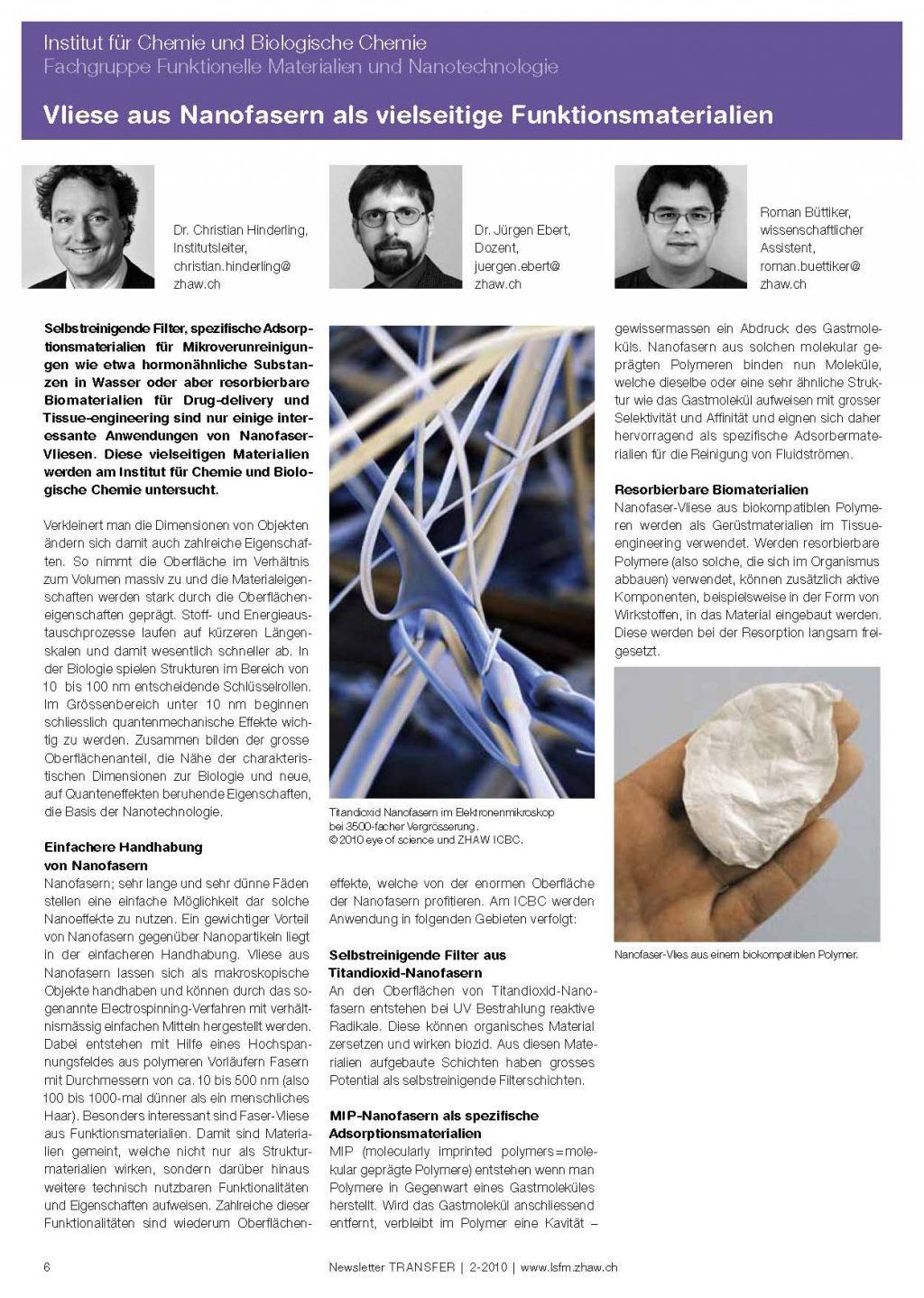Publications
Contributions/Article peer reviewed
Ulrich, A; Losert, S; Bendixen, Nina; Al-Kattan, A; Hagendorfer, H; Nowack, B; Adlhart, Christian; Ebert, Jürgen; Lattuada, M;Hungerbühler, K (2012). Critical aspects of sample handling for direct nanoparticle analysis and analytical challenges using asymmetric field flow fractionation in a multi-detector approach. Journal of Analytical Atomic Spectrometry , 27, 7. 1120-1130. Peer reviewed.
Büttiker, Roman; Ebert, Jürgen; Hinderling, Christian; Adlhart, Christian (2011). Membranes for Specific Adsorption: Immobilizing Molecularly Imprinted Polymer Microspheres using Electrospun Nanofibers. Chimia, 65 (3/2011). 182. Peer reviewed.
Posts, Articles/Articles
Ebert, Jürgen; Adlhart, Christian (2012). Intelligent nanofibres as basis for new filter materials. In: Global Guide of the Filtration and Separation Industry. Global Guide 2012-2014. (181-187). D-63322 Rödermark: VDL-Verlag.
Ebert, Jürgen; Adlhart, Christian (2012). Intelligent nanofibers as a basis for new filter materials. In: Global Guide of the Filtration and Separation Industry. Global Guide 2012-2014. (239-245). D-63322 Rödermark: VDL-Verlag.
Transfer Nr. 2 / September 2010
Nonwovens made from nanofibers as versatile functional materials
Short presentation / abstract
Self-cleaning filters, specific adsorption materials for micropollutants such as hormone-like substances in water or absorbable biomaterials for drug delivery and tissue engineering are just a few interesting applications of nanofiber nonwovens. These versatile materials are being investigated at the Institute of Chemistry and Biological Chemistry.
nanofibers; very long and very thin threads represent a simple way to use such nanoeffects. A major advantage of nanofibers over nanoparticles is that they are easier to handle. Nonwovens made of nanofibers can be handled as macroscopic objects and can be produced using the so-called electrospinning process with relatively simple means. With the help of a high-voltage field, polymer precursors create fibers with diameters of approximately 10 to 500 nm (i.e. 100 to 1000 times thinner than a human hair). Fiber fleeces made from functional materials are particularly interesting. This refers to materials that not only act as structural materials, but also have other technically usable functionalities and properties. Many of these functionalities are surface effects, which benefit from the enormous surface area of the nanofibers. At ICBC, applications are being pursued in the following areas:
- Self-cleaning filters made of titanium dioxide nanofibers
- MIP nanofibers as specific adsorption materials
- Absorbable biomaterials

Transfer No. 3 / December 2009
Zeta potential measurements for the characterization of filter aids
Short presentation / abstract
As part of the process filtration of beverages/food, chemical, pharmaceutical and bio-technological products, there are always undesirable losses of aroma or active ingredients during production and coagulation
Blood plasma filtration... which is due to the surface charge of the filter aid (FHM) used. Until now, the FHM has been based on the parameters grain size, permability, bulk density,...
characterized and not due to electrostatic
Adsorption properties. As part of the planned project, various filter aids such as diatomaceous earth, perlite and cellulose (including nanofibrillated cellulose) will be systematically examined and documented for their zeta potential. This would enable a targeted selection of one or more FHMs for the respective filtration task and thus a more optimal filtration with either improved filtration performance, less loss of active ingredient, higher yield - in summary with lower filtration costs.
Address
Hofbergstrasse 39 CH-9500 Wil / SG

